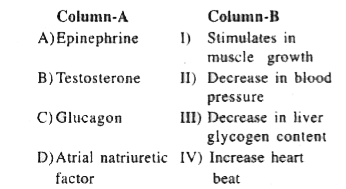In a bimolecular reaction, the steric factor P was experimentally determined to be 4.5. The correct options among the following is (are):
Experimentally determined value of frequency factor is higher than that predicted by Arrhenius equation
The value of frequency factor predicted by Arrhenius equation is higher than that determined experimentally
The activation energy of the reaction is unaffected by the value of the steric factor
Since P=4.5, the reaction will not proceed unless an effective catalyst is used
The correct Answer is:A, C
To solve the problem regarding the bimolecular reaction with a steric factor P of 4.5, we will analyze the implications of this value on the frequency factor A and the activation energy Ea.
1. Understanding Bimolecular Reactions:
- A bimolecular reaction involves two molecular species that collide to form products. The rate of such reactions is influenced by the orientation and energy of the colliding molecules.
2. Steric Factor P:
- The steric factor P is a measure of the probability that the colliding molecules will have the correct orientation for a reaction to occur. It is experimentally determined and can be greater than, less than, or equal to 1.
3. Given Information:
- In this case, P=4.5, which indicates that the probability of effective collisions is significantly higher than average.
4. Arrhenius Equation:
- The Arrhenius equation is given by:
k=Ae−EaRT
- Here, k is the rate constant, A is the frequency factor, Ea is the activation energy, R is the gas constant, and T is the temperature.
5. Relating P to the Frequency Factor:
- The relationship between the frequency factor A and the steric factor P can be expressed as:
A=Z⋅P
- Where Z is the collision frequency. Since P is greater than 1, it follows that A (the experimental frequency factor) must be greater than the theoretical frequency factor derived from the Arrhenius equation.
6. Evaluating the Options:
- Option 1: The experimentally determined value of the frequency factor is higher than predicted by Arrhenius. This is correct because P>1 implies Aexperimental>Atheoretical.
- Option 2: The value of the frequency factor predicted by the Arrhenius equation is higher than that determined experimentally. This is incorrect based on our previous analysis.
- Option 3: The activation energy of the reaction is unaffected by the value of the steric factor. This is correct because the activation energy is a separate parameter and is not influenced by the steric factor.
- Option 4: The reaction will not produce unless an effective catalyst is used. This is incorrect because the high value of P suggests that the reaction can proceed without an effective catalyst.
7. Conclusion:
- The correct options are Option 1 and Option 3.
- A bimolecular reaction involves two molecular species that collide to form products. The rate of such reactions is influenced by the orientation and energy of the colliding molecules.
- The steric factor P is a measure of the probability that the colliding molecules will have the correct orientation for a reaction to occur. It is experimentally determined and can be greater than, less than, or equal to 1.
- In this case, P=4.5, which indicates that the probability of effective collisions is significantly higher than average.
- The Arrhenius equation is given by:
k=Ae−EaRT
- Here, k is the rate constant, A is the frequency factor, Ea is the activation energy, R is the gas constant, and T is the temperature.
- The relationship between the frequency factor A and the steric factor P can be expressed as:
A=Z⋅P
- Where Z is the collision frequency. Since P is greater than 1, it follows that A (the experimental frequency factor) must be greater than the theoretical frequency factor derived from the Arrhenius equation.
- Option 1: The experimentally determined value of the frequency factor is higher than predicted by Arrhenius. This is correct because P>1 implies Aexperimental>Atheoretical.
- Option 2: The value of the frequency factor predicted by the Arrhenius equation is higher than that determined experimentally. This is incorrect based on our previous analysis.
- Option 3: The activation energy of the reaction is unaffected by the value of the steric factor. This is correct because the activation energy is a separate parameter and is not influenced by the steric factor.
- Option 4: The reaction will not produce unless an effective catalyst is used. This is incorrect because the high value of P suggests that the reaction can proceed without an effective catalyst.
- The correct options are Option 1 and Option 3.
Topper's Solved these Questions
- BOOK - VMC MODULES ENGLISHCHAPTER - CHEMICAL KINETICS EXERCISE - JEE Main (Archive)56videos
CHEMICAL KINETICS
- BOOK - VMC MODULES ENGLISHCHAPTER - CHEMICAL EQUILIBRIUMEXERCISE - IN-CHAPTER EXERCISE - G10videos
CHEMICAL EQUILIBRIUM
- BOOK - VMC MODULES ENGLISHCHAPTER - CHEMICAL THERMODYNAMICS EXERCISE - IN - CHAPTER EXERCISE - L10videos
CHEMICAL THERMODYNAMICS
Similar Questions
Knowledge Check
- Question 1 - Select One
Choose the correct option among the following.
 Aii,I,iii,ivBiv,I,iii,iiCI,ii,iii,ivDI,iv,ii,iii
Aii,I,iii,ivBiv,I,iii,iiCI,ii,iii,ivDI,iv,ii,iii
The correct option among the following is
View SolutionChoose the correct option among the following
 View Solution
View SolutionThe correct statement among the following is
View SolutionThe correct statements among the following is/are
View SolutionThe redox reaction among the following is
View SolutionThe correct statement among the following is/are
View SolutionThe correct statement among the following is:
View Solution

